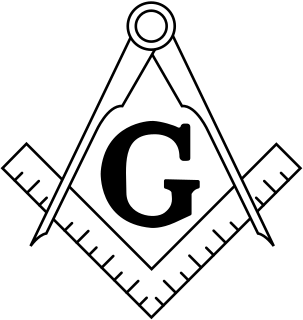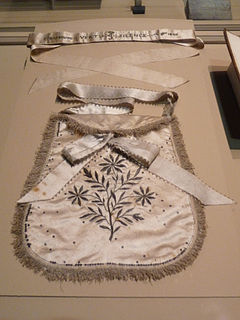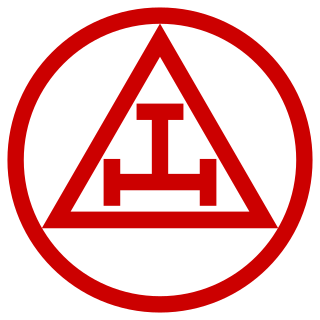Related Research Articles

Freemasonry or Masonry refers to fraternal organisations that trace their origins to the local guilds of stonemasons that, from the end of the 13th century, regulated the qualifications of stonemasons and their interaction with authorities and clients. Modern Freemasonry broadly consists of two main recognition groups:

Rosicrucianism is a spiritual and cultural movement that arose in Europe in the early 17th century after the publication of several texts purported to announce the existence of a hitherto unknown esoteric order to the world and made seeking its knowledge attractive to many. The mysterious doctrine of the order is "built on esoteric truths of the ancient past", which "concealed from the average man, provide insight into nature, the physical universe, and the spiritual realm." The manifestos do not elaborate extensively on the matter, but clearly combine references to Kabbalah, Hermeticism, alchemy, and Christian mysticism.

Arthur Edward Waite was a British poet and scholarly mystic who wrote extensively on occult and esoteric matters, and was the co-creator of the Rider–Waite tarot deck. As his biographer R. A. Gilbert described him, "Waite's name has survived because he was the first to attempt a systematic study of the history of western occultism—viewed as a spiritual tradition rather than as aspects of proto-science or as the pathology of religion."
The history of Freemasonry encompasses the origins, evolution and defining events of the fraternal organisation known as Freemasonry. It covers three phases. Firstly, the emergence of organised lodges of operative masons during the Middle Ages, then the admission of lay members as "accepted" or "speculative" masons, and finally the evolution of purely speculative lodges, and the emergence of Grand Lodges to govern them. The watershed in this process is generally taken to be the formation of the first Grand Lodge in London in 1717. The two difficulties facing historians are the paucity of written material, even down to the 19th century, and the misinformation generated by masons and non-masons alike from the earliest years.

The Rose Cross is a symbol largely associated with the legendary Christian Rosenkreuz; Christian Kabbalist, alchemist, and founder of the Rosicrucian Order. The Rose Cross is a cross with a rose at its centre, often red, golden or white and symbolizes the teachings of a Western esoteric tradition with Christian tenets.

William Preston was a Scottish author, editor and lecturer, born in Edinburgh. After attending school and college he became secretary to the linguist Thomas Ruddiman, who became his guardian on the death of his father. On the death of Thomas, Preston became a printer for Walter Ruddiman, Thomas' brother. In 1760 he moved to London and started a distinguished career with the printer William Strahan. He became a Freemason, instituting a system of lectures of instruction, and publishing Illustrations of Masonry, which ran to several editions. It was under Preston that the Lodge of Antiquity seceded from the Moderns Grand Lodge to become "The Grand Lodge of All England South of the River Trent" for ten years. He died on 1 April 1818, after a long illness, and was buried in St Paul's Cathedral.

Manly Palmer Hall was a Canadian author, lecturer, astrologer and mystic. Over his 70-year career he gave thousands of lectures, including two at Carnegie Hall, and published over 150 volumes, of which the best known is The Secret Teachings of All Ages (1928).
Jahbulon or Jabulon is a word which is allegedly used in some rituals of Royal Arch Masonry, and derivations thereof. It has been found to be speculation or even a European mispronunciation of the name Jehovah.

Freemasonry has had a complex relationship with women, which can be readily divided into many phases with no demonstrable relationship to each other until the 20th century. A few women were involved in Freemasonry before the 18th century; however the first printed constitutions of the Premier Grand Lodge of England appeared to bar them from the Craft forever.
Freemasonry in Denmark was first established in 1743 and is today represented by a number of Grand Lodges. The oldest and biggest Masonic Grand Lodge in Denmark is the Danish Order of Freemasons, in English also known as the Grand Lodge of Denmark.

Henry Pelham Holmes Bromwell was an American lawyer, politician from Illinois, and prominent Freemason. He was a lawyer and judge who served as a U.S. representative from Illinois from 1865–1869 and continued to practice law when he moved to Colorado in 1870 where he was appointed to compile the state's statutes. Bromwell was initiated into freemasonry in 1854, and he became the Grand Master of Illinois in 1864. When he moved to Colorado he became that state's first Honorary Grand Master. He developed the Free, and Accepted Architects, a new rite for Freemasonry which sought to teach its initiates the lost work of the craft embodied in Bromwell's Geometrical system. After his death, the Grand Lodge of Colorado published his work on the esoteric nature of Sacred geometry in the book Restorations of Masonic Geometry and Symbolry.

Rob Morris was a prominent American poet and Freemason. He also created the first ritual for what was to become the Order of the Eastern Star.

Alain Bernheim is a former French classical pianist and now a researcher and author based in Montreux, Switzerland.

The Royal Arch is a degree of Freemasonry. The Royal Arch is present in all main masonic systems, though in some it is worked as part of Craft ('mainstream') Freemasonry, and in others in an appendant ('additional') order. Royal Arch Masons meet as a Chapter; in the Supreme Order of the Holy Royal Arch as practised in the British Isles, much of Europe and the Commonwealth, Chapters confer the single degree of Royal Arch Mason.
Continental Freemasonry, also known as Liberal Freemasonry, Latin Freemasonry and Adogmatic Freemasonry, includes the Masonic lodges, primarily on the continent of Europe, that recognise the Grand Orient de France (GOdF) or belong to CLIPSAS, SIMPA, TRACIA, CIMAS, COMAM, CATENA, GLUA or any of various other international organizations of Liberal, i.e. Continental Freemasonry. The larger number of Freemasons, most of whom live in the USA, where Regular Freemasonry holds a virtual monopoly, belong to lodges that recognise the United Grand Lodge of England and do not recognise Continental Freemasons, regarding them as "irregular".
Freemasonry in France has been influential on the worldwide Masonic movement due to its founding of Continental Freemasonry.

Royal Arch Masonry is the first part of the York Rite system of the Masonic degrees. Royal Arch Masons meet as a Chapter, and the Royal Arch Chapter confers four degrees: Mark Master Mason, Past Master, Most Excellent Master, and Royal Arch Mason.
John J. Robinson was an American author, best known as the author of Born in Blood: The Lost Secrets of Freemasonry. He is also credited as being the "founding visionary" of the Masonic Information Center run by the Masonic Service Association of North America. He was a member of the Medieval Academy of America, the Organization of American Historians, and the Royal Over-Seas League of London.
General Charles Rainsford was a British Army officer.
Cyrus Field Willard was an American journalist, political activist, and theosophist. Deeply influenced by the writing of Edward Bellamy, Willard is best remembered as a principal in several utopian socialist enterprises, including the late 1890s colonization efforts of the Brotherhood of the Cooperative Commonwealth (BCC).
References
- ↑ R.C.S. Trahair, Utopias and Utopians: An Historical Dictionary (Westport, CT: Greenwood, 1999), pp. 442–43
- ↑ H.G. Liddell & R. Scott, A Greek-English Lexicon (New York: Oxford University Press, 1968), 1924, p. 1931
- ↑ Kenneth Mackenzie, The Royal Masonic Cyclopaedia (London: J.W. Bouton, 1877, 1877), pp. 561–62
- ↑ Charles Porset, Les Philalethes Et Les Convents de Paris: Une Politique de La Folie (Paris: H. Champion, 1996).
- ↑ Ray V. Denslow, "Masonic Rites and Degrees." Transactions of the Missouri Lodge of Research, 12 (1955), p. 212
- ↑ Cyrus Field Willard, "What's in a Name." Square and Compass, Vol. 45, No. 7 (Sept., 1936), pp. 20–23.
- ↑ Allen E. Roberts, Seekers of Truth (Highland Springs, VA: 1988), p. 3
- ↑ Allen E. Roberts, Seekers of Truth (Highland Springs, VA: 1988), p. 7